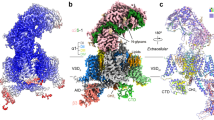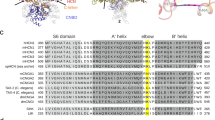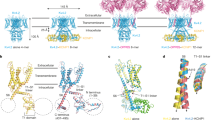Abstract
High-voltage-activated Ca2+ channels are essential for diverse biological processes. They are composed of four or five subunits, including α1, α2-δ, β and γ (ref. 1). Their expression and function are critically dependent on the β-subunit, which transports α1 to the surface membrane and regulates diverse channel properties2,3,4. It is believed3,4,5,6 that the β-subunit interacts with α1 primarily through the β-interaction domain (BID), which binds directly to the α-interaction domain (AID) of α17; however, the molecular mechanism of the α1–β interaction is largely unclear. Here we report the crystal structures of the conserved core region of β3, alone and in complex with AID, and of β4 alone. The structures show that the β-subunit core contains two interacting domains: a Src homology 3 (SH3) domain and a guanylate kinase (GK) domain. The AID binds to a hydrophobic groove in the GK domain through extensive interactions, conferring extremely high affinity between α1 and β-subunits4,8. The BID is essential both for the structural integrity of and for bridging the SH3 and GK domains, but it does not participate directly in binding α1. The presence of multiple protein-interacting modules in the β-subunit opens a new dimension to its function as a multi-functional protein.
This is a preview of subscription content, access via your institution
Access options
Subscribe to this journal
Receive 51 print issues and online access
$199.00 per year
only $3.90 per issue
Buy this article
- Purchase on Springer Link
- Instant access to full article PDF
Prices may be subject to local taxes which are calculated during checkout





Similar content being viewed by others
References
Catterall, W. A. Structure and regulation of voltage-gated Ca2+ channels. Annu. Rev. Cell Dev. Biol. 16, 521–555 (2000)
Birnbaumer, L. et al. Structures and functions of calcium channel beta subunits. J. Bioenerg. Biomembr. 30, 357–375 (1998)
Arikkath, J. & Campbell, K. P. Auxiliary subunits: essential components of the voltage-gated calcium channel complex. Curr. Opin. Neurobiol. 13, 298–307 (2003)
Dolphin, A. C. β subunits of voltage-gated calcium channels. J. Bioenerg. Biomembr. 55, 607–627 (2003)
De Waard, M., Pragnell, M. & Campbell, K. P. Ca2+ channel regulation by a conserved beta subunit domain. Neuron 13, 495–503 (1994)
De Waard, M., Scott, V. E., Pragnell, M. & Campbell, K. P. Identification of critical amino acids involved in α1-β interaction in voltage-dependent Ca2+ channels. FEBS Lett. 380, 272–276 (1996)
Pragnell, M. et al. Calcium channel β-subunit binds to a conserved motif in the I–II cytoplasmic linker of the α1-subunit. Nature 368, 67–70 (1994)
Canti, C. et al. Evidence for two concentration-dependent processes for β-subunit effects on α1B calcium channels. Biophys. J. 81, 1439–1451 (2001)
Opatowsky, Y., Chomsky-Hecht, O., Kang, M. G., Campbell, K. P. & Hirsch, J. A. The voltage-dependent calcium channel beta subunit contains two stable interacting domains. J. Biol. Chem. 278, 52323–52332 (2003)
Hanlon, M. R., Berrow, N. S., Dolphin, A. C. & Wallace, B. A. Modelling of a voltage-dependent Ca2+ channel beta subunit as a basis for understanding its functional properties. FEBS Lett. 445, 366–370 (1999)
Hendrickson, W. A. Determination of macromolecular structures from anomalous diffraction of synchrotron radiation. Science 254, 51–58 (1991)
Tavares, G. A., Panepucci, E. H. & Brunger, A. T. Structural characterization of the intramolecular interaction between the SH3 and guanylate kinase domains of PSD-95. Mol. Cell 8, 1313–1325 (2001)
Zarrinpar, A., Bhattacharyya, R. P. & Lim, W. A. The structure and function of proline recognition domains. Sci. STKE 2003, RE8 (2003)
Larson, S. M. & Davidson, A. R. The identification of conserved interactions within the SH3 domain by alignment of sequences and structures. Protein Sci. 9, 2170–2180 (2000)
Blaszcyk, J., Li, Y., Yan, H. & Ji, X. Crystal structure of unligated guanylate kinase from yeast reveals GMP-induced conformational changes. J. Mol. Biol. 307, 247–257 (2001)
Sheng, M. & Pak, D. T. Ligand-gated ion channel interactions with cytoskeletal and signaling proteins. Annu. Rev. Physiol. 62, 755–778 (2000)
Beguin, P. et al. Regulation of Ca2+ channel expression at the cell surface by the small G-protein kir/Gem. Nature 411, 701–706 (2001)
Finlin, B. S., Crump, S. M., Satin, J. & Andres, D. A. Regulation of voltage-gated calcium channel activity by the Rem and Rad GTPases. Proc. Natl Acad. Sci. USA 100, 14469–14474 (2003)
McGee, A. W. et al. Structure of the SH3-guanylate kinase module from PSD-95 suggests a mechanism for regulated assembly of MAGUK scaffolding proteins. Mol. Cell 8, 1291–1301 (2001)
Garcia, E. P. et al. SAP90 binds and clusters kainate receptors causing incomplete desensitization. Neuron 21, 727–739 (1998)
Maximov, A., Sudhof, T. C. & Bezprozvanny, I. Association of neuronal calcium channels with modular adaptor proteins. J. Biol. Chem. 274, 24453–24456 (1999)
Otwinowski, Z. & Minor, W. Processing of X-ray diffraction data collected in oscillation mode. Methods Enzymol. 276, 307–326 (1997)
Terwilliger, T. C. & Berendzen, J. Automated MAD and MIR structure solution. Acta Crystallogr. D 55, 849–861 (1999)
Jones, T. A., Zou, J. Y.,, Cowan, S. W. & Kjeldgaard, M. Improved methods for building protein models in electron density maps and the location of errors in these models. Acta Crystallogr. A 47, 110–119 (1991)
Brunger, A. T. et al. Crystallography & NMR system: A new software suite for macromolecular structure determination. Acta Crystallogr. D 54, 905–921 (1998)
Jogl, G., Tao, X., Xu, Y. & Tong, L. COMO: a program for combined molecular replacement. Acta Crystallogr. D 57, 1127–1134 (2001)
Wu, L., Bauer, C. S., Zhen, X. G., Xie, C. & Yang, J. Dual regulation of voltage-gated calcium channels by PtdIns(4,5)P2. Nature 419, 947–952 (2002)
Carson, M. Ribbon models of macromolecules. J. Mol. Graph. 5, 103–106 (1987)
Nicholls, A., Sharp, K. & Honig, B. H. Protein folding and association: insights from the interfacial and thermodynamic properties of hydrocarbons. Proteins Struct. Funct. Genet. 11, 281–296 (1991)
Kraulis, P. MOLSCRIPT: a program to produce both detailed and schematic plots of protein structures. J. Appl. Crystallogr. 24, 946–950 (1991)
Acknowledgements
We thank Y. Mori for CaV2.1 complementary DNA; E. Perez-Reyes for all β-subunit cDNAs; T. Tanabe for α2δ cDNA; and the staff at X4A of NSLS, Brookhaven National Laboratory, for synchrotron support. This work was supported by grants to L.T. and J.Y. from the National Institutes of Health. J.Y. is a recipient of the McKnight Scholar Award, the Scholar Research Programme of the EJLB Foundation and the Established Investigator Award of the American Heart Association.
Author information
Authors and Affiliations
Corresponding author
Ethics declarations
Competing interests
The authors declare that they have no competing financial interests.
Supplementary information
Supplementary Figure 1
Comparison of the structures of the core region of Ca2+ channel β subunits. (DOC 2325 kb)
Supplementary Figure 2
BID is not directly involved in binding AID. (DOC 784 kb)
Supplementary Figure 3
Stimulation of Ca2+ channel expression by an artificial peptide. (DOC 530 kb)
Supplementary Figure 4
Quality of structural models. (DOC 1782 kb)
Supplementary Table 1
Crystallographic Data, phasing statistics, and refinement statistics. (DOC 43 kb)
Rights and permissions
About this article
Cite this article
Chen, Yh., Li, Mh., Zhang, Y. et al. Structural basis of the α1–β subunit interaction of voltage-gated Ca2+ channels. Nature 429, 675–680 (2004). https://doi.org/10.1038/nature02641
Received:
Accepted:
Published:
Issue Date:
DOI: https://doi.org/10.1038/nature02641
This article is cited by
-
EMC chaperone–CaV structure reveals an ion channel assembly intermediate
Nature (2023)
-
Cavβ surface charged residues contribute to the regulation of neuronal calcium channels
Molecular Brain (2022)
-
Selective posttranslational inhibition of CaVβ1-associated voltage-dependent calcium channels with a functionalized nanobody
Nature Communications (2022)
-
Excitation-contraction coupling in skeletal muscle: recent progress and unanswered questions
Biophysical Reviews (2020)
-
Increase of CaV3 channel activity induced by HVA β1b-subunit is not mediated by a physical interaction
BMC Research Notes (2018)
Comments
By submitting a comment you agree to abide by our Terms and Community Guidelines. If you find something abusive or that does not comply with our terms or guidelines please flag it as inappropriate.



